多媒体通信与网络PPT课件
- 格式:ppt
- 大小:11.83 MB
- 文档页数:39
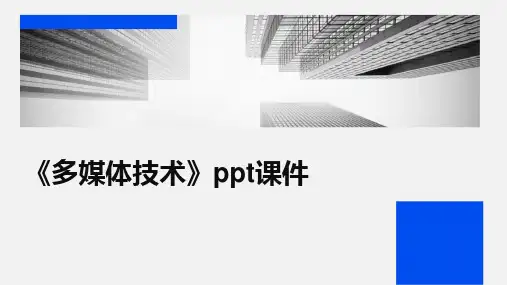
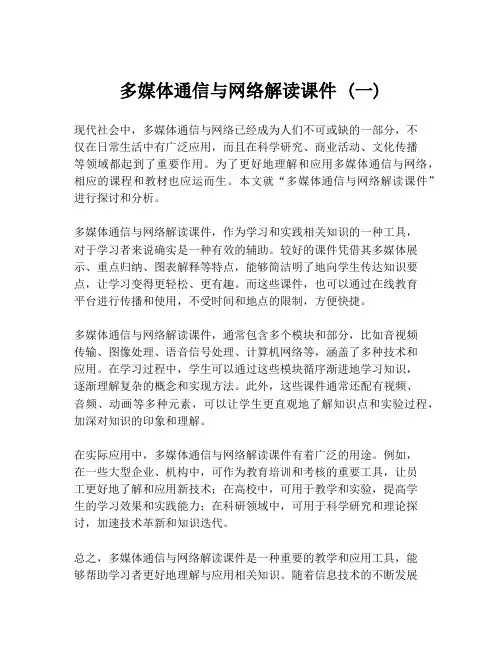
多媒体通信与网络解读课件 (一)现代社会中,多媒体通信与网络已经成为人们不可或缺的一部分,不仅在日常生活中有广泛应用,而且在科学研究、商业活动、文化传播等领域都起到了重要作用。
为了更好地理解和应用多媒体通信与网络,相应的课程和教材也应运而生。
本文就“多媒体通信与网络解读课件”进行探讨和分析。
多媒体通信与网络解读课件,作为学习和实践相关知识的一种工具,对于学习者来说确实是一种有效的辅助。
较好的课件凭借其多媒体展示、重点归纳、图表解释等特点,能够简洁明了地向学生传达知识要点,让学习变得更轻松、更有趣。
而这些课件,也可以通过在线教育平台进行传播和使用,不受时间和地点的限制,方便快捷。
多媒体通信与网络解读课件,通常包含多个模块和部分,比如音视频传输、图像处理、语音信号处理、计算机网络等,涵盖了多种技术和应用。
在学习过程中,学生可以通过这些模块循序渐进地学习知识,逐渐理解复杂的概念和实现方法。
此外,这些课件通常还配有视频、音频、动画等多种元素,可以让学生更直观地了解知识点和实验过程,加深对知识的印象和理解。
在实际应用中,多媒体通信与网络解读课件有着广泛的用途。
例如,在一些大型企业、机构中,可作为教育培训和考核的重要工具,让员工更好地了解和应用新技术;在高校中,可用于教学和实验,提高学生的学习效果和实践能力;在科研领域中,可用于科学研究和理论探讨,加速技术革新和知识迭代。
总之,多媒体通信与网络解读课件是一种重要的教学和应用工具,能够帮助学习者更好地理解与应用相关知识。
随着信息技术的不断发展和升级,我们也期待着这种工具能够更好地满足学习和应用的需求,开发出更加优质、丰富的课程和模块,为现代社会的发展和繁荣做出应有的贡献。



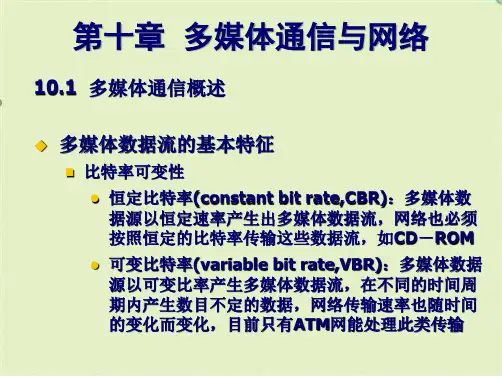
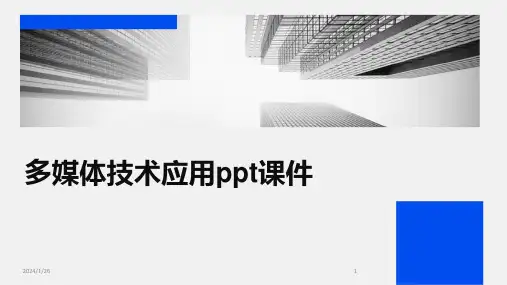

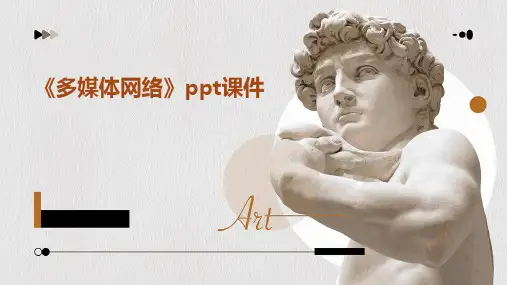


第九章IP多媒体通信和网络新体制●9.1 IP分组多媒体通信●9.2 新一代网络与软交换技术●9.3 IMS●9.4 IPTV及其组网MultiMedia CommunicationBased on Packet Network Architecture, Protocols, Progress●Overview●Protocols (H.323 & SIP)●IP Telephone ArchitectureOverview●FeaturesMultimedia Communication (MMC) means more than one set of forms comprisingstill/moving images, graphic, text, and soundare reproduced on an intelligent terminal●Implementation of MMC–Transmission media•Wireless ( Radio, Microwave, Satellite,…)•Wired ( Twisted Pair, Cable, Optic Fiber,…)–Switching•Circuit-switched ( traditional CS, fast CS,…)•Packet-switched (ATM,MPLS , Ethernet, FR ,Token ring, Token bus), X.25,…)–Media processing•Sampling ( 8Khz, 16Khz, …)•Coding( G.711 A/ -law for voice, …)•Compressing /Dec ompressing( G723.1, G729A, for voice; H.261/H.263, JPEG (Joint Photographic Experts Group), MPEG-4 (Motion Picture ExpertsGroup)for Video•Storing , editing,…MMC network architectureIntegratedAccessComputer NetCATV ModemV5/ No.7, No.1PSTNxDSL CO.LAN LAN Copper/Optical LANPSTN Telephone Fiber/ Cable Cable IP Tel Cable Tel Cable ModemIP Tel PSTN TelApplicationsDistance teaching/learning interac-tively, examination on-network,…VoD (video on demand), Live picture, on-line game/Chat, …Trading, shopping, stock exchange,banking, …News, magazine, forum, E-mail,…Examples AreasEducation Entertainment ElectronicCommercePublic Info.ProtocolsH.323•Specified by ITU in 1996 ( V2, 1998)•Describes the protocols stacks of terminal equipments, and services for multimedia communication over LAN and IP networks•These networks don’t provide guaranteed QoS (Quality of Services).Generally speaking,MMC includes almost all techniques in info.processing , transmission , and switching , the limited-space makes our discussion to packet-based network.IP Backbone RTCP H.225.0(Sig. Ch.)H.245 Control and managementIP Video CodingAudio Coding Gatekeeper Gateway Client Terminal H.323 ArchitectureNIC ( Network Interface Controller)TCP PBX ApplicationUDP RTP H.225.0(RAS )Main Components in H.323–Terminal: media processing and call control•PC, Video/TV, Telephone, Fax, ….•H.323-compliant( multimedia-PC,Telephone,…)•Other terminals:–H.320 terminal on N_ISDN–H.310/H.321 terminal on B_ISDN using ATM–H.324 terminal on PSTN–Gateway: translation of call signaling, media format, multiplexing , etc.–Gatekeeper网闸: providing administration of access, bandwidth, address translation, etc.H.323 Protocols StackAudio CodingG.711, G.722, G.723.1, G.726, G.728, G.729Video CodingH.261, H.263RTP(Real-Time Trans. Prot.)Processing related to sequencing, sync., payloadtype, source identification,…RTCP Additional info. to session participants: QoS feedback, identification, session control,…RAS (H.225.0)RAS: Registration, Admission, StatusConveying the registration, admissions, bandwidth, status, …UDP Efficient but unreliable transport of packets Ch. CTRL (H.245)Capability Negotiation, coding, conference req.,… Sign. Ch. (H.225.0)setup or release of call connection based on Q.931TCPConn.-oriented , reliable transport of packets ItemsProtocols or FunctionH.323 Protocols Stack-video coding/decoding H.261:compression/decompression of digital video, specified by ITU in 1990 , P*64kbps, mainly in ISDN, (from M777 p52)H.263, defined by ITU, compression of the moving picture component of audio-visual service at low bit rates.JPEG treats its picture independently( intraframe coding)while H.261 tries to predict the current picture from the previous one (interframe coding)MPEG-Motion Picture Experts Group, belongs a family of ISO/IEC (International Electrical Committee )MPEG-1uses the same format as H.261, but allows a greater choice of image sizeMPEG-2developed by ISO/IEC, ITU , up to 100Mbps for Video, supports HDTVMPEG-4video coding method for low bit ratesH.323 Protocols Stack-RTP/RTCP comments RTP comments:Sequencing: sequence nu. for detecting lost packetsSync.: timestamps to compensate the different delay jitter, needed by player-out buffers.Payload: identified the encoding of media, to change the encoding of media dynamically due to the bandwidth availability.Source identification: identifier for the originator of the frame in multicast session.RTCP comments:In RTP session, the participants periodically send RTCP packets to obtain QoS info, etc.QoS feedback: no. of lost packets, round-trip time, jitter, etc.Session CTRL: leaving a session by sending BYE packetIdentification: info. such as e-mail, name, phoneIntermedia Sync.: synchronizing the video and audio for receiverSIP#Developed by IETF MMUSIC(Multi-Party Multimedia Session Control)work group, evolved from HTTP–SIP features•Open, simple, and lightweight protocol•Text –based protocol (text: 文本、明文)•Internet heritage –easier to integrate withtelephony/Video and Internet functions•Already implemented on most soft-switches andgateways•Advanced extensibility•Transport independent-TCP or UDP(reliability for both)–SIP Architecture (next page)NICIP 7SIP ProxyControl and managementSIP ArchitectureRedirect Server2346891011SIP Client 1Request Response121Agent Server Location Service5SIP Client 2SIP ProxySIP TerminalTCPUDP Video/Audio codingRTPRTCPApplication✓SIP Components●Clients–End systems–Send SIP requests–Usually contain SIPuser agent server ●Redirect Server–“Network” server; redirectsusers to try other server(user agent may act as aredirect server)●User Agent Server–Listens for callrequests–Prompts user orexecutes program todetermine response ●Proxy Server–“Network Server” Proxiesrequest to another server(user agent also may do this)–Can “fork” request tomultiple servers, creating asearch tree注解:agent接近用户,proxy一般远离用户;(仅对SIP)前者翻译为SIP message example(the below message is from RFC2543)INVITE sip:watson@ SIP/2.0 Via:SIP/2.0/UDP 169.130.12.5From:<sip:a.g.bell@>To:T. A. Watson <sip:watson@> Call-ID:187602141351@ Content-Length:885Encryption:PGP version=2.6.2, encoding=ascii NOTE: "MIME security with pretty good privacy(PGP)", RFC 2015,October 1996.SIP has only a limited number of methods:1)Invite, 2)ACK, 3)Options, 4)Bye, 5)Cancel, 6)RegisterH.323 vs. SIPMessagesDevelop & Update Complicated Elements & Interactions Hundreds,ComplicatedSetup of a task V.1(call,ctrl,media) 3round-trip, V.2 faststartExtensibility( Codecs)ITU developed only MarketBecoming lessMobility supportLimitedScalability (largenumber of call processing )State Binary-based Easy 37 headers,SimpleSingle round-tripAny registered Growing extensivelyEasierState or stateless Text-based ItemsH.323SIPIP TelephoneGeneral–DefinitionIn contrast to traditional telephone in CS network, it means real-time services, such as voice, video, etc, transferred in best-effort PS network.–Brief history TimeEventsMarch,1995First commercial IP phone for PC’s1999~High density (4~8 T1/E1), large capacity (>100T1)1997~1998Part commercial application 1996PC-to-phone,Phone-to-phone PlayersVocaltecAudiocodes, analogic,NMS,…Vocaltec, Net2phone,…Free world Dialup,MIT,…IP Phone NetworkIP backbone networkNew YorkTelephoneFaxGatekeeperPSTNGatewayTelephoneFaxGatekeeperPSTNGatewayShanghaiTelephoneFAX GatekeeperPSTNGatewayHong Kong–Call Progress•Pick the hook up (Off-hooks), dial special servicenumber,ex 17900 for China Telecom•Voice response: Please input account & password•When it is OK, voice response: input the callednumber,ex 86-21-56781234# for Shanghai•Voice response: the time allowed XXX, please wait•Local Gateway performs PSTN-IP translation , sendnecessary info. to remote gateway by using H.323 or SIP•Remote gateway is ringing to the called user,performs the negotiation of parameters, such ascoding, RTP/RTCP sessions,etc.•If user answered, the info. is sent to original gateway •Voice transmission beginsPayload RTP Header 12 Bytes UDP header 8 Bytes IP Header 20 Bytes •Transmission and switching in packet network, ex. Ethernet, FR, ATM,…•Disassemble : extracted voice payload from the IP Packet •Voice payload →decompression (echo canceling, gain control,..)→reproduced Voice •PCM(64Kb/s)→compression →8Kb/s(G.729a),…•Encapsulation ( packetized ):–Voice Processing–Coding ComparisonCodingG.711G.728NetCoder G.723.1G.729aRate(Kbps)64168N/A Very good N/A Very high (40)Good 8 or 16 ms Moderate (10)Fair 10ms(2X5)6.4/5.3Moderate-High (14/20)Good/Fair 30ms (4X7.5)9.6/8.0/7.2Low (7.5)Very good(-)20msComplexity (MIPS)Quality Frame Size–Death of distance, distance becomes less significant–Very low price,even free (More calls with less bandwidth)In china, domestic toll 1 Yuan/min, IP 0.3 Yuan/min –Provide integrated voice, data, image by one terminal–Web-based multimedia services,…unacceptablePoor Good Excellent 0450300150One-way in ms Quality vs. Latency–Limited and finite in capacity, area–Significant drawbacks (gap, influent, click noise,..) in network congestion, or in large-delayed route,…Comments:These were really true when this presentation was written in 2000>450Latest Advanced Products (around 2000)Company Analogic Audiocode Natural Micro-SystemDialogicModel TAP-810TP-400AG4000D/300PCI-E1D/300SC-2E1 Max. nu.of T1/E1441,2,42BusInterface cPCI cPCI cPCI or PCI PCI or SC ExtendedInterface H.110H.110H.110H.100DSP TMS320-C549AudioCodeAC48105TMS320-C549Motorla5630XOn-BoardEthernet10/100M100Base-T no noChannels ofcompression120/96120/96120/96 (plusdaughter board)60/48 (plusdaughter board)OS Solaris,UNIX,Win NT Win NTWin NT,SolarisWin NTSolaris,UNIXSDK TAP-8XX-Fusion-Advantages (advanced)DSP DSP,RTP/RTCP on-boardEasy to R&DLocal serviceWideserviceDis-advantages Hard inR&DHard inR&DDaughterboardLow density Analogic Audiocode Natural Micro-SystemDialogicCompany–Hardware: Higher density, integrated more functions into one board or chassis , ex. a DSP daughter board is inserted to main board, now it is not used any more.–In software•Support more OS, extend to Solaris , Unix,…•Support more signaling , for example, SS7,…•Support new protocols being developed, ex. provides open MGCP•Some software is embedded into board, NMS put itsRTP/RTCP on board–In China, the gateway with capacity up to 160 E1 has been developed–Application-oriented, web-based( 800,…), call transfer,…–New application, IP-based-PBX, call centre, telephone bank,…Question: could you describe the similarities and dissimilarities/differences between call-free services in modes of the traditional telephone and Internet web-based ?ProductsIn ChinaChina had chosen H.323 as the standard useddomesticallyThere are a lot of players to announce to provide SIP solution, e.g., capital telecom company.It is reasonable to say that the largest telecomcompanies provide the SIP solutions in two years,such as Zhongxing, Huawei .(this was really truewhen the PPT was written in 1999)Today, there are more and more manufacturersinvolved in SIP products, which presents the futureof IP-based multimedia communication !ProductsInternationalThere are a lots of H.323-based products used widely, including telephone (hardware/software), Gateways, Gatekeepers, MCUs(Multi-points Control Unit), etc. The playersinclude Audiocodes, Cisco, Clarent( 冠远),Dialogic, Nortel networks, Lucent,…There are a few hundreds players to providesolutions of SIP, e.g., Audiocodes, Nortelnetworks, Lucent,…The futureThe SIP will become more and more important, but it takes a long way to coexist with H.323 and to replace (?) absolutelyThe researching topics include:H.323 interworking with SIPH.323 and SIP applications in wired and wireless networks(3G -3rd generation, WLAN,…)H.323/SIP interworking with Softswitch system (H.248, wediscuss it in next section)IP Multimedia Subsystem (IMS #)-a new networkingarchitecture, widely used and dominates the session control protocol in mobile networks (3G,4G) and mixed Fixed/mobile networksAppendixQuality of Voice is measured via MOS#: Mean Opinion Score(5~1), 5 Is the best and 1 is the worstG.726 ADPCM 8K~32K (Adaptive Differential PCM)G.728 LD-CELP (Low Delay of Code Excited Linear Predictive)G.729# CS-ACELP (Constant-Structure, Algebraic CELP)G.723.1 6.4K MP-MLQ ( Multi Pulse, Maximum –LikelihoodQuantization) 5.3K ACELPWe must note that ITU compression algorithms are not the best.According to , its NetCoder quality at 9.6 Kbps isindistinguishable from G.711 PCM.PCI#–Peripheral Component InterconnectioncPCI#—compact PCI , SC-widely used computer bus in the pastH.100/H.110is CT ( Computer Telephony) Bus implementation on thePCI/cPCI form.H.100: 4096 bi-directional time slotsH.110: 32 data streams at 8.192Mb/s.OS:Operation System SDK#:Software Development Kit第九章多媒体通信和网络新体制●9.1 IP分组多媒体通信●9.2 新一代网络及其发展●9.3 IMS●9.4 IPTV及其组网1.1下一代网络的基本概念●泛指一个大量采用创新技术,以分组传送和IP应用为中心,可以支持语音、数据和多媒体业务的融合网络;●NGN,不是现有网的简单延伸和迭加,是一个不断发展的概念和过程;●从业务上看:应支持话音,视频和多媒体业务;●从网络上看:垂直方向应包括(top-to-down方向)业务层/控制层/传送层(传送层又分为核心/汇聚/接入3个子层),水平方向应覆盖用户驻地网、接入网和核心网;●从技术特征看:希望有传统电话网的普遍性和可靠性;因特网的灵活性;以太网的运作简单性;ATM的低延时;光网络的带宽;蜂窝网的移动性;有线电视网的丰富内容。